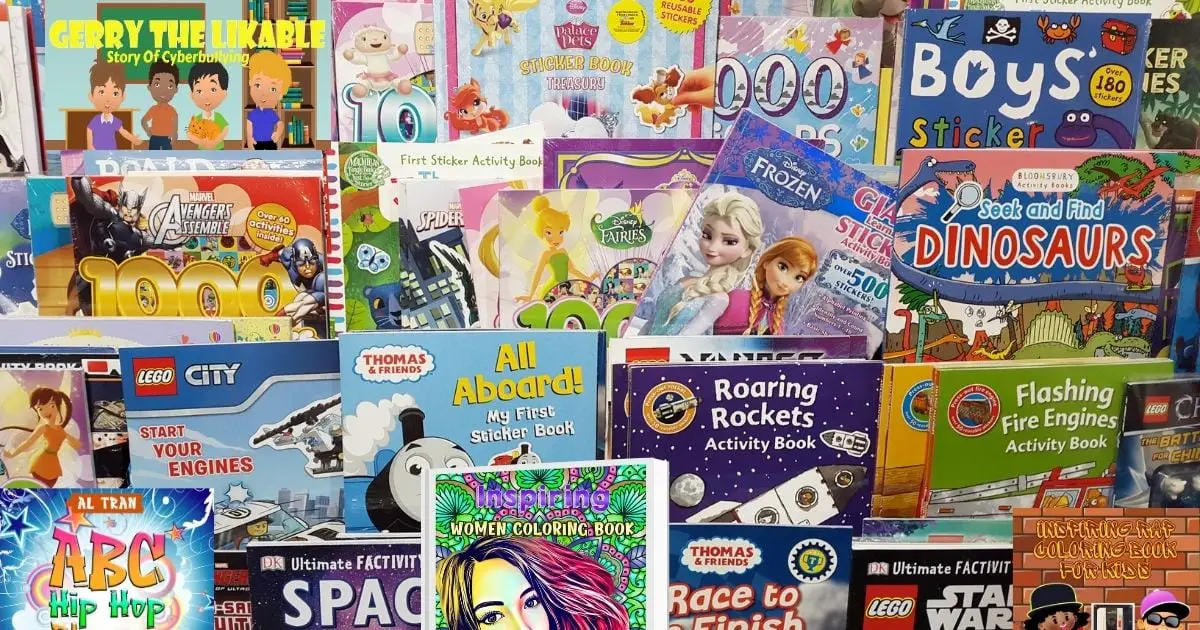In this comprehensive guide, we’ll explore the advantages and disadvantages of reading multiple books simultaneously, offering insights to help you make an informed decision. Reading multiple books can help you stay interested in reading but can be a big distraction at the same time so let’s see if it is right for you.
Yes, reading multiple books at the same time can be beneficial for various reasons. However, it’s essential to consider individual preferences, reading habits, and the potential impact on comprehension and enjoyment.
Reading multiple books at the same time does not mean holding two books in your hand and trying to read both books at the same time as this is difficult to do and a waste of time and you learn nothing. What reading multiple books at the same time means is switching between books and not switching like a crazy person every 30 seconds, but maybe a chapter or more till you get bored of that book and find another book to read as this can help keep you from boredom.
1. Understanding the Dynamics of Multitasking in Reading

What Does Reading Multiple Books Entail?
Engaging with multiple books simultaneously, a practice often called multitasking reading differs significantly from sequential reading in which one completes a book before commencing another. This approach demands the division of attention and cognitive resources across various narratives. Thereby, potentially cultivating an eclectic reading experience. Switching often between genres, authors, or topics. This is a process that enables readers to simultaneously explore an array of perspectives and ideas.
Embarking on multitasking reading, individuals choose books rooted in personal interests, academic pursuits, or leisure preferences. This creates a diverse, intellectually curious reading list. Unlike sequential reading which fixates on the completion of one book at a time, multitasking reading encourages dynamic flexibility when consuming literature. Engaging concurrently with multiple books, readers experience a richer and more varied literary journey. Their horizons expand beyond the confines of a single narrative.
Cognitive Load and Attention Management
Reading multiple books concurrently, your cognitive resources are distributed across various narratives, characters, and themes. This distribution can enhance both attention management skills and cognitive flexibility. As you switch between diverse contexts, your brain adapts accordingly. To multitask reading effectively demands active mental engagement, tracking numerous storylines, analyzing intricate themes, and all this while simultaneously retaining information from an array of sources.
Managing cognitive load indeed involves multitasking reading, which in turn challenges the reader to exercise selective attention and task-switching abilities. This process requires alternating between multiple books. Individuals therefore prioritize information processing, efficiently allocating mental resources. This fosters cognitive flexibility which is an adaptive learning strategy that enhances problem-solving skills by allowing readers not just to navigate through but masterfully maneuver complexities within numerous narratives. Engaging in multitasking reading cultivates a dynamic cognitive environment, one that actively promotes intellectual growth and enhances critical thinking skills.
Emotional Engagement and Reader Empathy
Simultaneously engaging with diverse narratives, readers encounter a range of emotional experiences and perspectives. This engagement potentially cultivates not only empathy but also emotional intelligence. It challenges readers to identify with characters from varying backgrounds and situations. Adopting a multitasking approach to reading, immersing oneself in an array of emotional landscapes, is encouraged. these can span the spectrum from joyous triumphs, all the way through heart-wrenching sorrows or deep despair.
Encountering a vast array of emotions in various narratives cultivates empathy and compassion, not only for fictional characters but also for real-life individuals. Through navigating the complexities of human experiences via literature, readers foster an enriched understanding of human emotions and behaviors. This engagement with emotion operates as the catalyst that propels empathy. It prompts readers to immerse themselves in diverse character perspectives to sympathize with their struggles, celebrate their victories, and acknowledge their vulnerabilities.
Essentially, multitasking reading acts as a catalyst for emotional growth and interpersonal understanding. It enhances the reader’s capacity, augments their empathy, and deepens their compassion.
Motivation and Reading Satisfaction
Alternating between multiple books can deter monotony and sustain reading interest for certain individuals. Switching genres or topics, based on mood or preference, over time, cultivates enhanced satisfaction in reading. Moreover, it fuels motivation. Multitasking within the act of reading bestows upon readers a unique advantage. It provides them with flexibility and an opportunity to customize their experience tailored specifically to suit ever-changing interests and preferences.
Engaging with multiple books simultaneously not only stimulates curiosity and intellectual involvement but also ignites an intense sense of excitement and anticipation. Each book introduces fresh avenues for exploration and breakthroughs, thereby inspiring readers to immerse themselves further into a variety of subject matter and narratives.
Embracing multitasking reading thus allows individuals to nurture a lifelong passion for learning as well as literature. This enriches their overall reading experience while cultivating feelings of fulfillment, even accomplishment. The joy of discovery, the satisfaction derived from intellectual growth and the infinite possibilities for personal enrichment and self-improvement ultimately constitute the intrinsic rewards of multitasking reading.
2. Benefits of Reading Multiple Books Simultaneously

Broadened Intellectual Horizons
Concurrently exploring multiple books, readers broaden their exposure to a myriad of ideas, concepts, and genres. This not only cultivates intellectual curiosity but also fosters lifelong learning by urging them beyond the confines of familiar subjects or genres.
Engaging in multitasking reading presents an unparalleled opportunity for immersion in diverse intellectual landscapes ranging from historical non-fiction through speculative fiction, and philosophy to psychology. Each book is a gateway to novel perspectives and insights. It broadens the reader’s comprehension of our world and enriches their intellectual horizons.
Engaging with multiple books simultaneously facilitates interdisciplinary thinking. It establishes connections between seemingly unrelated topics. Through such engagement, readers often unearth unexpected parallels among disparate subjects, these discoveries ignite creative insights and instigate novel approaches to problem-solving.
Reading multiple books is an interdisciplinary approach that not only fosters a holistic understanding of complex issues but also cultivates intellectual agility, as readers master the art of navigating across different disciplines within knowledge’s interconnected web. Broadened intellectual horizons ultimately empower individuals. They approach learning with an open mind, and thirst for knowledge, embracing the endless possibilities of intellectual growth and discovery. This is a state where one’s propensity toward acquiring new information flourishes.

Improved Cognitive Skills
Simultaneously engaging with multiple narratives challenges the brain. It must process and retain information from various sources. This cognitive exercise, enhancing memory retention, critical thinking, and analytical reasoning skills, contribute significantly to overall cognitive development.
Moreover, multitasking reading stimulates an array of cognitive processes, from pattern recognition to inference-making. Readers, in their navigation through the intricacies of multiple storylines and characters, truly engage in mental gymnastics that bolster their capacity for comprehension.
Switching between different books demands cognitive flexibility and adaptability. Readers must recalibrate their mental schema to accommodate diverse narrative structures and writing styles. This act of cognitive flexibility strengthens neural connections in the brain. It bolsters not only resilience but also adaptability to face novel challenges.
Moreover, when engaging in multitasking reading, a practice that encourages active involvement with text, one promotes deeper comprehension and retention of information. Multitasking reading is a mental workout that challenges the brain to simultaneously process information from various sources. In doing so, it strengthens cognitive skills, an action that fiercely promotes lifelong learning.
Enhanced Time Management
Individuals with demanding schedules can harness their available reading time more efficiently by multitasking, and juggling multiple books. This strategy maximizes productivity without tethering readers to the compulsion of finishing one book before commencing another. Thus, it provides flexibility in routine and a personalized approach tailored to individual lifestyles and preferences. Whether squeezing in a few pages during the commute or indulging in chapters before bed, multitasking reading empowers its users for optimal use of their literary engagements.
Moreover, the capacity to transition between books following mood or context endows readers with a sustained momentum and circumvents reading fatigue. Individuals are not relegated to plow through one book only. They can instead oscillate amidst various genres or topics, thus infusing their reading experience with freshness and engagement. This adaptability intensifies satisfaction from reading as well as motivation. It empowers readers to customize their literary journeys according to personal preferences and lifestyle factors. Enhanced time management, ultimately achieved through multitasking reading.
The ability to read multiple books empowers individuals to prioritize their daily demands and still make space for literature. In turn, fostering a lifelong love of learning. This is the power behind mastering efficient time allocation in your life.
3. Considerations Before Embracing Multitasking Reading

Potential for Reduced Comprehension
Concurrently reading multiple books may decrease comprehension, and dividing attention among numerous narratives hampers deep engagement with each text. The result is a superficial understanding of intricate themes or plotlines. To multitask in reading, one must distribute cognitive resources across various storylines, characters, and settings, potentially leading to cognitive overload and difficulties in processing information. Consequently, full immersion in each book by readers may present a challenge. This leads to fragmented reading experiences and reduced comprehension.
Additionally, multitasking during reading could hamper the ability of a reader to analyze and synthesize information coherently. They might face difficulties in identifying overarching themes or establishing connections among various elements across several narratives.
Moreover, the threat of diminished comprehension in multitasking reading highlights the significance of employing efficient strategies to alleviate cognitive overload and amplify understanding. Adopting active reading techniques like text annotation, key point summarization, and involvement in reflective practices may boost readers’ advantage. Each book receives deeper engagement through these strategies. Furthermore, they encourage readers’ active processing and evaluation of content thereby promoting comprehensive understanding.
When readers set explicit reading objectives and prioritize concentrated sessions, they can sustain their focus and concentration. This approach minimizes the potential for compromised comprehension during multitasking reading.

Risk of Overwhelm and Burnout
Multitasking reading might overwhelm or burn out some readers, especially those grappling with tracking numerous storylines or themes. Such a struggle over time could dampen their motivation and enjoyment of reading. Balancing the demands of several books concurrently, an activity we term multitasking in reading, could mentally tax and emotionally drain certain individuals. Navigating between different narratives, readers may experience cognitive fatigue and decision fatigue are factors that could result in diminished reading satisfaction, even reduced engagement.
The potential for overwhelm and burnout in juggling multiple reading tasks underlines the critical role of self-awareness and self-care in the efficient management of reading habits. Readers must keenly observe their cognitive and emotional reactions to this multitasking act, subsequently adapting their approach. It might require establishing boundaries around reading time, setting achievable goals for readings, as well as giving priority to self-care activities – all pivotal measures to avert burnout.
Moreover, individuals who seek support from reading communities or discuss their challenges with peers often gain valuable insights and strategies to manage overwhelm and burnout. Prioritizing mental well-being and adopting a mindful approach to reading empowers one to navigate the complexities of multitasking reading with resilience. It brings balance into this intricate process.

Personal Reading Preferences and Habits
The suitability of multitasking reading significantly hinges on individual preferences and habits. Some readers flourish with variety, relishing the challenge of managing multiple books. Others immerse themselves completely in one narrative at a time, preferring quality over quantity. However, it is crucial to note that this approach of multitasking reading is not universally applicable. Cognitive preferences, attention span, and specific reading goals are factors that vary from person to person, these all influence its viability.
Multitasking reading is a practice that permits certain individuals to venture into diverse genres and topics simultaneously. They find it not just stimulating but invigorating. Yet, some may experience the opposite. Multitasking reading could overwhelm or distract, thus diminishing their sought-after immersive experience with literature.
Understanding personal reading preferences and habits proves essential in the development of a balanced, sustainable reading routine. One must reflect on their own goals and habits to ascertain whether multitasking aligns with one’s needs. This self-reflection may require experimentation with various reading approaches; soliciting feedback from trusted sources, and even adjusting current habits based on personal experiences could be necessary steps towards an optimal strategy for effective consumption of literature.
Embracing personal reading preferences and habits ultimately empowers individuals. It enables them to cultivate a fulfilling, enriching reading practice that resonates with their unique interests and aspirations.
Conclusion
To conclude, individual preferences, habits, and goals guide the decision to concurrently read multiple books. Multitasking in reading presents a host of potential advantages. It broadens one’s intellectual horizons and sharpens cognitive skills but we must not overlook possible disadvantages. Reduced comprehension and an elevated risk of overwhelm are among these potential drawbacks.
By comprehending the dynamics and implementing effective strategies for multitasking reading, one can optimize their experience, harnessing benefits from engaging with diverse narratives simultaneously becomes readily achievable. Choose to embrace multitasking reading or prefer a more sequential approach. Regardless of your preference, cultivate a reading routine that aligns with your unique goals and enriches not only personal growth but also intellectual development.





